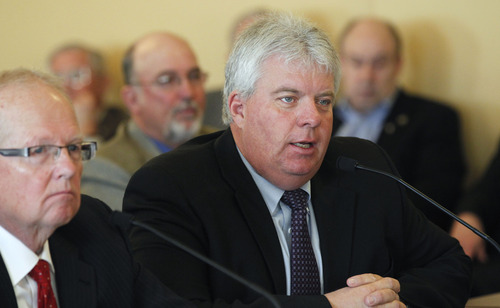This is an archived article that was published on sltrib.com in 2013, and information in the article may be outdated. It is provided only for personal research purposes and may not be reprinted.
When Don Peay founded Sportsmen for Fish and Wildlife in 1993, few could have dreamed that it would blossom into a powerful multimillion-dollar operation with a presence in seven Western states and in national politics.
The group formed as Utah mule deer populations were crashing. Peay, an avid hunter, decided to do something about it.
There is little doubt that Sportsmen for Fish and Wildlife has done much good. It has spent money to purchase or improve wildlife habitat and raised $7.2 million for conservation over the past 10 years. It recently wrote a check for more than $1 million to the Utah Division of Wildlife Resources.
Such expenditures bring the organization sway with state wildlife managers. Some think the relationship might be too cozy. Money and political clout often give the impression that SFW and not the DWR is in charge of wildlife in Utah.
Consider a 2010 Utah Wildlife Board meeting when SFW president Byron Bateman presented then-DWR director Jim Karpowitz with a check for $391,000 moments before the Wildlife Board passed a controversial proposal largely crafted and promoted by SFW to reduce the number of deer-hunting permits by at least 13,000.
I fear that the organization has become increasingly more about making money for its officers, commercializing Utah's wildlife and aligning itself with groups such as off-highway vehicle organizations and right-wing politicians intent on Utah taking over federal public lands. How these things help wildlife or the average hunter escapes me.
Some of SFW's fundraising efforts concern me — especially those taking advantage of hunters' mythical fears that the main reason for the decline in big-game herds, such as mule deer, is predation. Damn the biology or the fact that the reasons deer herds are down are far more complex. Advocating killing wolves, coyotes, cougars and bears to save deer, elk and other big game is a great way to raise funds and gain members. No matter that wiping out predators is ecologically questionable and, except in a few specific units, not particularly effective.
The organization successfully lobbied the Utah Legislature to appropriate general tax dollars as well as raise hunting license fees to increase bounties on coyotes, encouraging the wanton killing of coyotes everywhere. I can't find a single reputable biologist who thinks this action will help deer herds. But the simplistic solution sounds good to uninformed legislators and hunters and helps raise money.
The Utah Legislature also gave an offshoot SFW organization called Big Game Forever a second $300,000 contract to lobby Washington politicians to keep wolves out of Utah. Though a few stray wolves may have wandered into northern Utah, there is no evidence wolves ever are going to be a major problem in the state. There has been no detailed report as to how Big Game Forever spent the first $300,000. The group is not registered to lobby in Washington, D.C.
SFW and its officers also donate money freely to dozens of politicians.
One of the recipients was State Sen. Ralph Okerlund, R-Monroe, who received $6,500 in campaign contributions from Peay and Ryan Benson, co-founder of Big Game Forever. Okerlund, the Senate majority leader, recommended spending $300,000 this year on Big Game Forever's anti-wolf lobbying campaign.
Figuring out just how much Peay and other officers make in salary or consulting fees is challenging. Money is moved back and forth from nonprofits to private corporations among groups such as Sportsmen for Fish and Wildlife, Sportsmen for Habitat, Big Game Forever, Arctic Red River Outfitters, Peay Consulting, World Trophy Outfitters, the Full Curl Society, the Foundation for North American Wild Sheep, seven state chapters of SFW and the Mule Deer Foundation — which is part of a major wildlife convention where the state gives conservation organizations wildlife tags to auction. The groups get to keep 10 percent of the proceeds for administrative costs. In the case of application fees raised at the 2012 Western Hunting and Conservation Expo, hunters pay in hopes of drawing a difficult-to-get hunting tag, SFW and the Mule Deer Foundation reported $613,572 in expenses of holding the drawing, with the remaining $443,417 actually going to conservation projects.
Has any of this helped big game in Utah? You be the judge.
The number of deer hunters afield dropped from 146,008 in 1993, when SFW was founded, to 80,425 in 2011. The number of bucks killed dropped from 23,024 to 21,291. The number of antelope, moose and bison that hunters and animals harvested also declined during that same time period.
The success stories are elk and bighorn sheep. Utah elk hunters have increased from 48,372 in 1993 to 57,241 in 2011, with the bull harvest going from 6,066 to 6,923. The bighorn sheep harvest jumped from 17 in 1993 to 54 in 2011.
While SFW and its many subsidiaries might do some good for wildlife, those who donate thinking they are helping big game should realize that many of these groups' officers have a heavy financial stake in the operation. And the continued commercialization of the public's wildlife should cause concern that herds are being managed not on the basis of sound biology but in ways to produce more cash.
Twitter: @tribtomwharton



